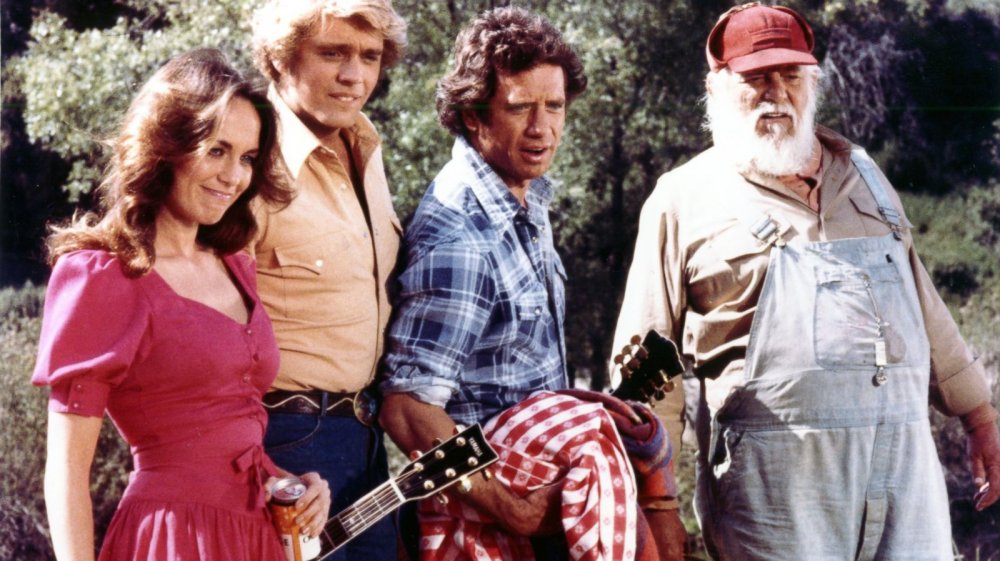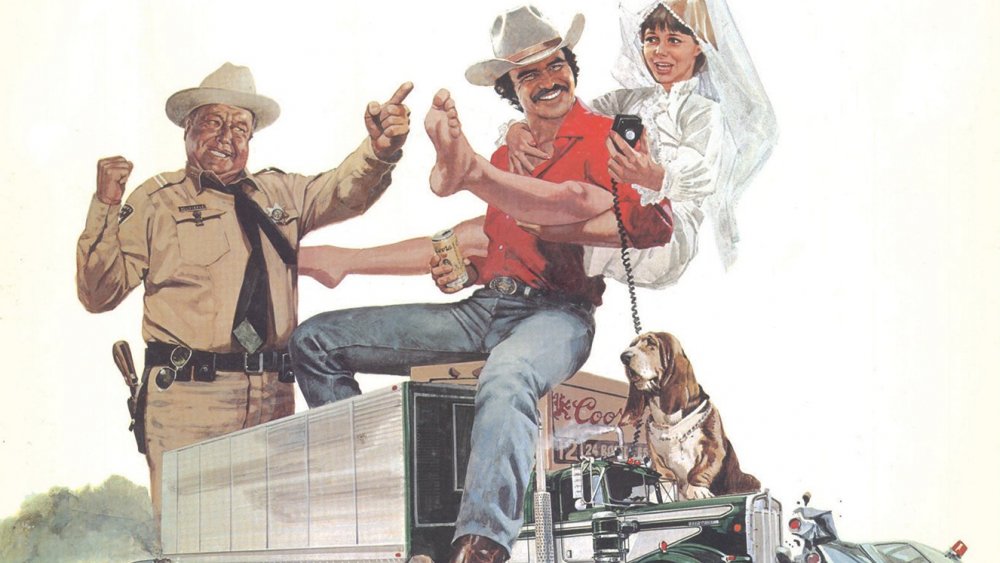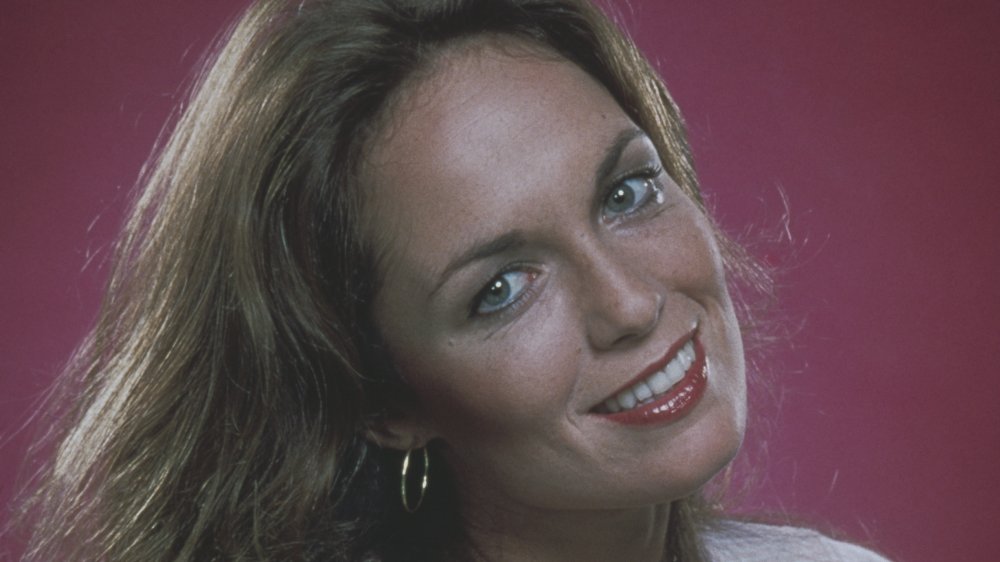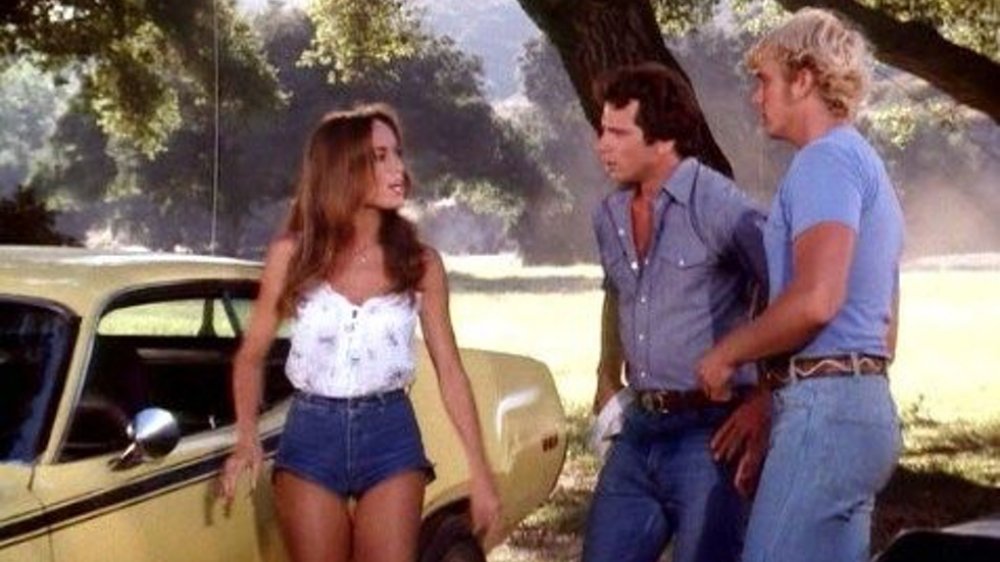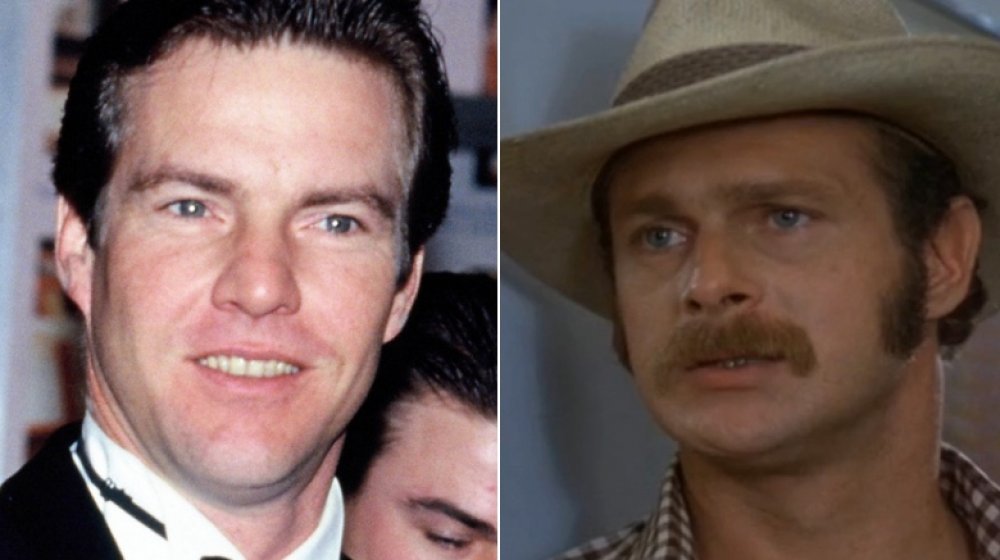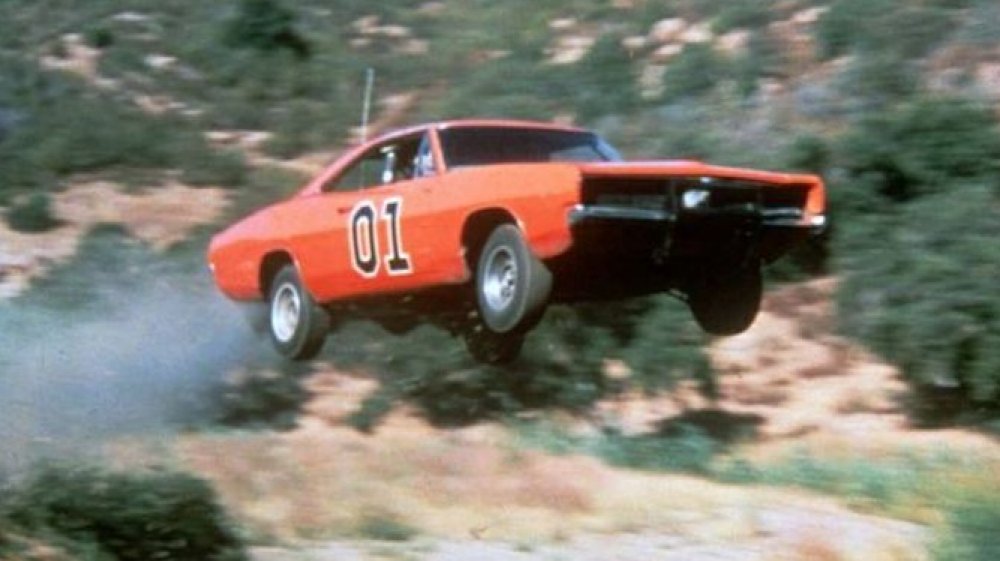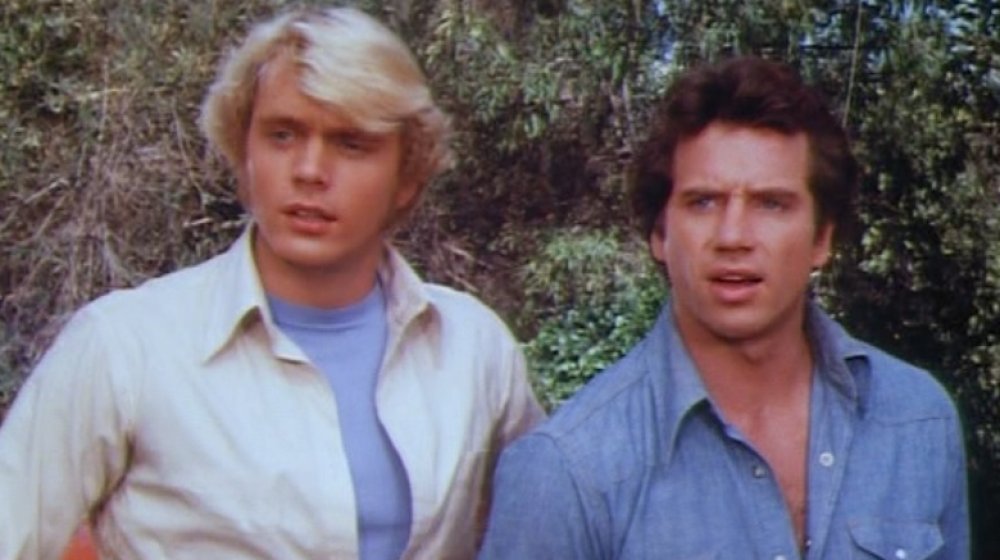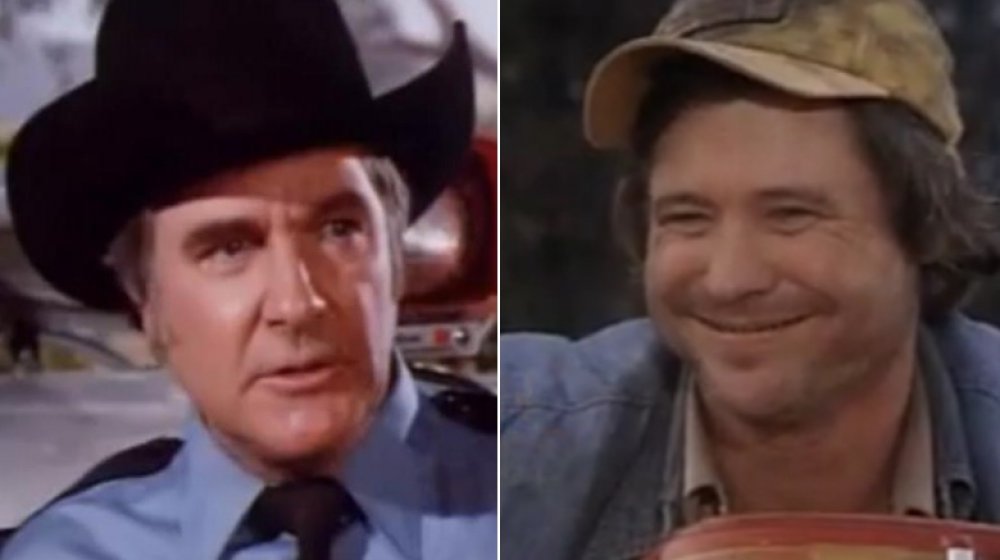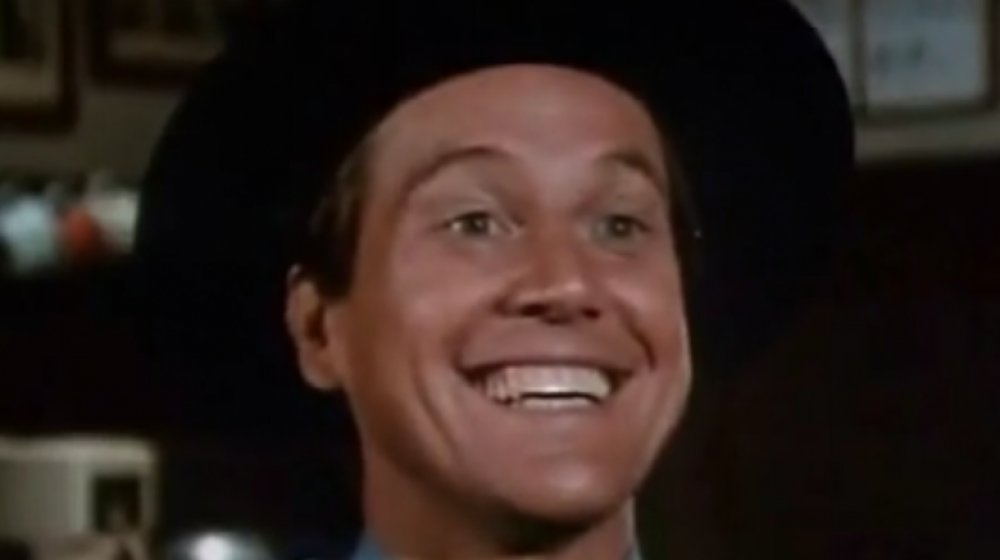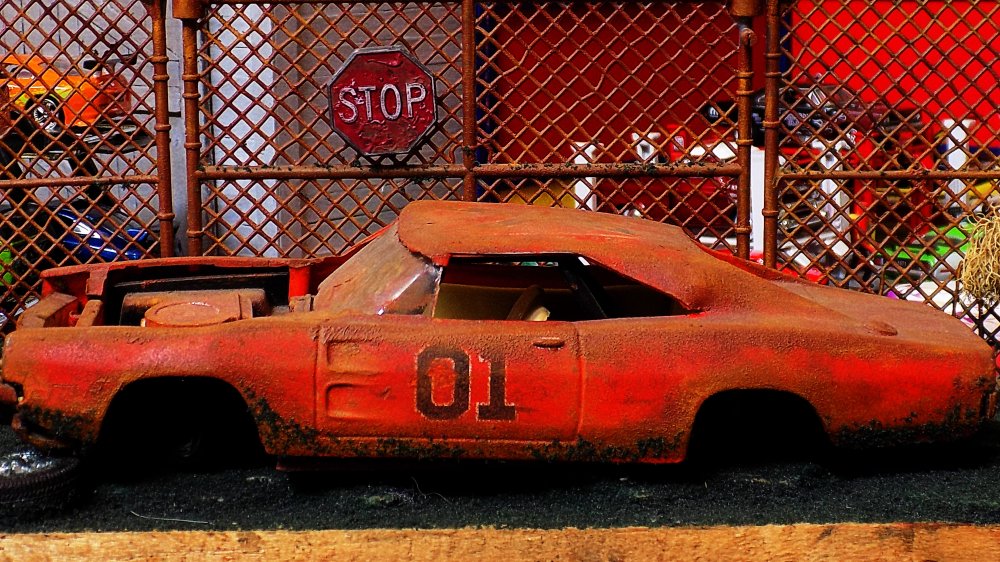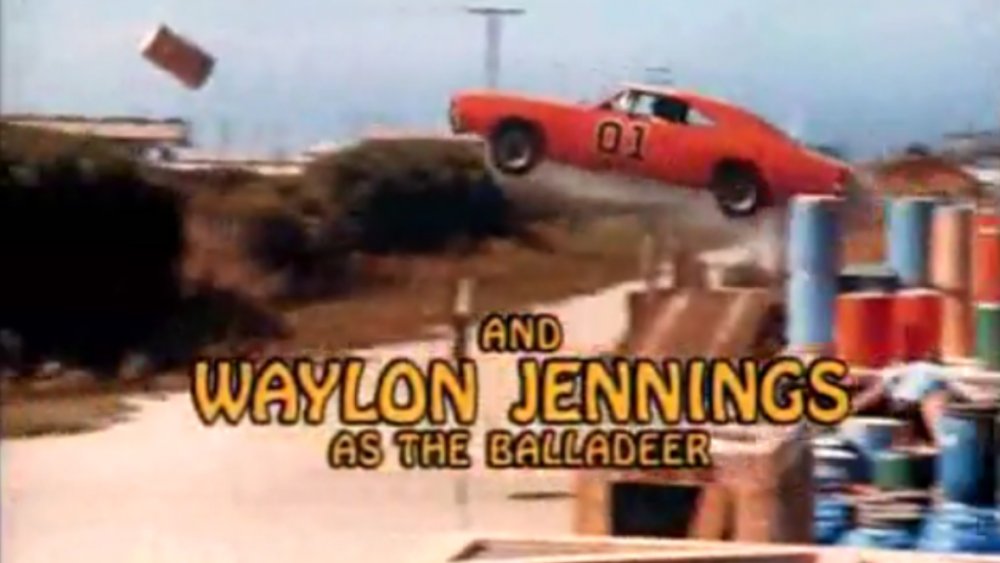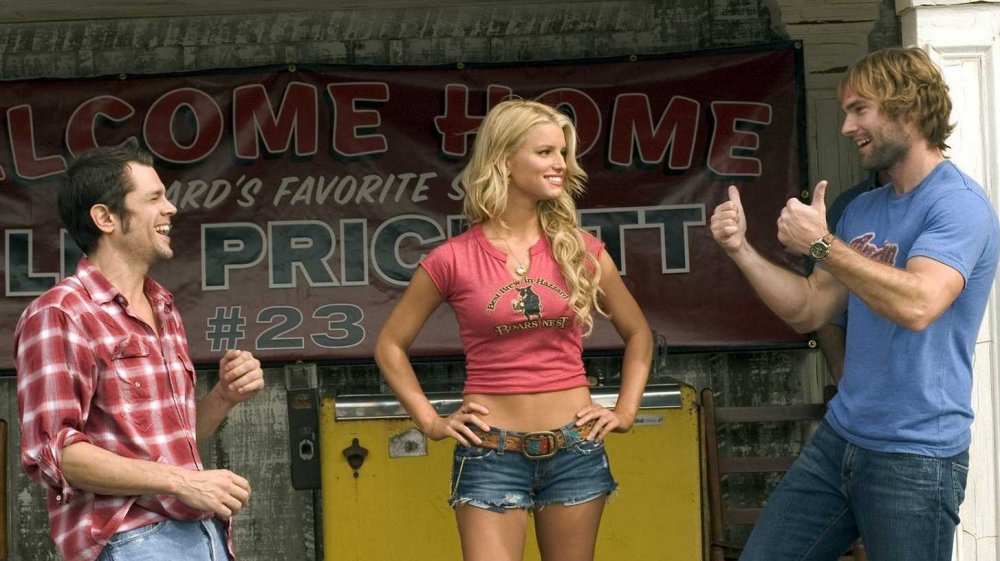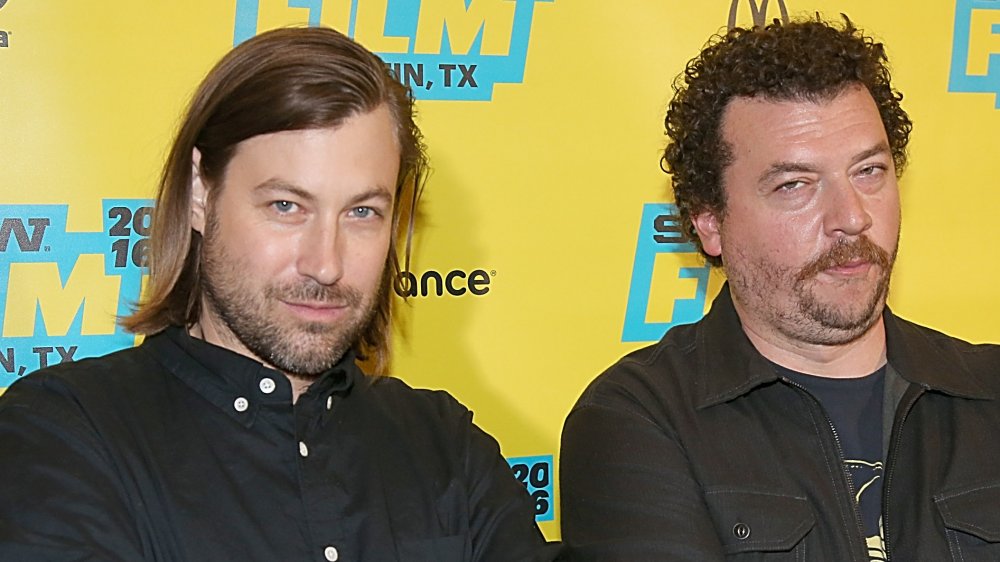The Untold Truth Of The Dukes Of Hazzard
The Dukes of Hazzard was one of the most successful television shows of the 1970s and 1980s. The series, a Friday-night staple from 1979 to 1985, ranked as high as #2 in the ratings during its run, as millions of viewers each week checked in on the criminal underbelly of the rural Hazzard County, Georgia, and the corrupt and incompetent local law enforcement that kept it in check. Dukes was about a couple of good ol' boys, cousins Bo Duke and Luke Duke, who were never meaning no harm, but were also on probation for moonshining. Handsome young actors John Schneider and Tom Wopat played Bo and Luke, respectively, as they got into scrapes with their short-shorts-wearing cousin Daisy Duke (Catherine Bach) and tried to evade corrupt county commissioner Boss Hogg (Sorrell Booke) and Sheriff Rosco P. Coltrane (James Best) with the aid of their souped-up orange Dodge Charger, the "General Lee."
The Dukes of Hazzard is one of the most entertaining and enduring shows in TV history, with a production story just as exciting and unpredictable. Here's the behind-the-scenes saga (and legacy) of "them Duke boys."
The show is rooted in a '70s movie fad
Southern culture was all the rage in the United States in the late 1970s. Perhaps an outgrowth of the rise of Georgia peanut farmer-turned-governor-turned-president Jimmy Carter, millions of Americans were briefly fascinated with movies, TV shows, music, and fads with a Southern flavor. Country music artists like Kenny Rogers and Dolly Parton crossed over to the higher reaches of the mainstream pop charts. Smokey and the Bandit starring Burt Reynolds was the fourth-highest-grossing movie of 1977, and The Dukes of Hazzard was a massive hit for CBS.
The show was a television adaptation of Moonrunners, a relatively obscure Southern action comedy that played in a handful of movie theaters in 1975. The plot: Cousins Bobby and Grady Lee transport illegal moonshine for their Uncle Jesse, and the proceedings are narrated by "The Balladeer," voiced by Waylon Jennings. (In other words, it's got a very similar premise as The Dukes of Hazzard; the main difference is that the cousins in the TV show used to run moonshine.) The popularity of Smokey helped lead to CBS acquiring The Dukes of Hazzard, even though CBS chairman William Paley thought the network would be "a laughingstock" if they put it on the air.
Nobody wanted Catherine Bach to play Daisy Duke
Bob Clark produced Moonrunners, and he was friends with David Shaw, who in the late 1970s was married to actor Catherine Bach. Clark gave Shaw and Bach the heads-up that she might want to audition for The Dukes of Hazzard, the TV adaptation of Moonrunners, despite the fact that the tall, svelte, dark-haired performer did not fit the type producers were after for Daisy Duke.
"They were looking for a particular type of girl — lots of blonde hair and an hourglass figure," Bach told the Beaver County Times. Her looks had also cost her work already — she was told she appeared "too exotic" for TV, and had failed to land a role on Charlie's Angels. Nevertheless, Bach secured an audition with Moonrunners writer-director (and Dukes creator) Gy Waldron, apart from the Warner Bros. executives overseeing the series. "The producers and business people were out sick that day, so Gy snuck me over to CBS," Bach said in The Dukes of Hazzard: The Unofficial Companion. "I got the part before anybody could say no."
But once Warner brass found out about Bach, they objected and tried to recast Daisy Duke with a new actor, even after the show had already started airing. Once the show — and Bach — proved popular with viewers, Warners backed down.
Daisy Duke nearly lost the Daisy Dukes
Because of her role as wholesome but sultry Dukes of Hazzard character Daisy Duke, Catherine Bach became a late '70s sex symbol and pin-up (literally — a poster of her sold millions of copies). That's due in large part to what Bach most often wore on television: tight-fitting and extremely short shorts of various styles and colors. Such garments became so popular that even four decades later, they're colloquially referred to as "Daisy Dukes," named for the character.
Daisy's tiny pants are thus very associated with The Dukes of Hazzard, but they almost didn't make it to television. At the outset of the series, producers and costumers planned for Bach to wear vinyl boots along with a skirt in the same pattern as the tablecloths at the Boar's Nest, Boss Hogg's tavern where Daisy Duke worked. Bach didn't like that idea, so she sewed her own costume based on what she saw waitresses in actual Southern bars wearing — denim shorts. That's what the character wore, but it's not all that she wore. In order to satisfy censors (and to ensure that Bach didn't accidentally expose more than just her legs), she had to wear pantyhose underneath the shorts.
The Dukes of Hazzard from another dimension
John Schneider and Tom Wopat shot to instant fame in 1979 as the stars of The Dukes of Hazzard. Playing Bo Duke and Luke Duke marked the first time that either actor had ever landed a speaking part in anything.
Schneider heavily pursued the role. After finding out that producers wanted an authentic rural-raised actor for Bo, the New York-born performer faked it — he borrowed a pickup truck to drive to the audition, and walked in wearing boots and carrying a six-pack of beer, cracking one open as he went. (He got the gig.)
Wopat landed the role of Luke Duke only after some other, slightly more seasoned actors couldn't play it. Future soap opera and Renegade star Lorenzo Lamas auditioned, as did Simon & Simon lead Gerald McRaney. Eventual movie star Dennis Quaid virtually had the part, but he only wanted to sign on if his wife at the time, P.J. Soles (Halloween, Carrie), was given the role of Daisy Duke. She wasn't right for that part, so Quaid didn't get his.
It was all about the General Lee
Despite the involvement of human stars Tom Wopat, John Schneider, and Catherine Bach, the real star of The Dukes of Hazzard was the General Lee. Named after Civil War general Robert E. Lee, the General Lee is the orange, overpowered, late '60s model Dodge Charger that takes Bo and Luke to, from, and through their various scrapes and adventures. At the show's peak of popularity in the early 1980s, according to the New York Times, the production received 60,000 fan letters each month. Of those, more than 35,000 were about the General Lee, generally requests for information about the car, or a photograph. Those fans (and plenty of others) bought a lot of Dukes of Hazzard merchandise. Warner Bros. estimated it would sell about $100 million worth of General Lee toy cars and other items, a number it cited in a lawsuit against Gay Toys, a company that almost got away with selling unauthorized merchandise featuring the car.
The centerpiece of most Dukes episodes was a stunt involving the General Lee — landing a seemingly impossible jump without incurring any damage, for example. That's just Hollywood magic, because the production went through more than 150 different Dodge Chargers that "portrayed" the General Lee. Warner Bros. actively sought out candidates in public places, leaving purchase offers on Charger windshields in parking lots and operating a body shop whose sole duty it was to paint and improve those cars until they were screen-worthy.
Bo and Luke Duke left the show for a while
After a few seasons as one of the most-watched shows on television, The Dukes of Hazzard was selling a lot of merchandise, such as toys, T-shirts, and lunch boxes. According to the New York Times, it generated around $125 million a year in this way, not to mention the lucrative advertising revenue coming in on a weekly basis. The two guys who carried the burden of bringing the show to life, actors John Schneider and Tom Wopat, didn't think they were being fairly compensated, or getting a big enough piece of the pie.
In 1982, the two stars threatened to leave the show unless studio Warner Bros. gave them a salary bump and a percentage of the merchandise profits. Warner called the actors' bluff and not only let them leave Dukes, but created a massive public search for their replacements. The studio auditioned about 2,300 men, and from that group selected Byron Cherry and Christopher Mayer to play two brand new Duke cousins named Coy and Vance. (The absence of Bo and Luke was explained — they left Hazzard County to join the NASCAR circuit.)
When the new Dukes came in, audiences left Dukes. The show fell out of the top 10 and all the way down to #34 for the 1982-83 season. Warners soon thereafter offered Schneider and Wopat attractive contract extensions. Bo and Luke came back, and Coy and Vance disappeared.
Rosco P. Coltrane and Cooter left, too
Not only did The Dukes of Hazzard lose its main characters, Bo and Luke Duke, for a year when actors John Schneider and Tom Wopat walked away over a financial dispute with producers, but the series dealt with other cast departures throughout its seven-season run. Sheriff Rosco P. Coltrane didn't appear in several episodes in the show's second season, leaving the Duke cousins to square off against substitute bad sheriffs Grady Byrd (Dick Sargent) and Buster Moon (James Hampton). The reason: Rosco P. Coltrane actor James Best briefly left the show because of his dressing room, or lack thereof.
"My dressing room was a bunch of 50-year-old plywood boxes that they dragged around on a tractor," Best told the Ames Tribune (via MeTV) in 2014. Then, to clean up the actor after his character invariably and hilariously fell down in mud, Best would "stand between two blankets while someone hosed me down." Best returned to the show when his request for proper dressing quarters with a shower was granted.
After producers asked actor Ben Jones to shave his beard, he also disappeared from Hazzard County for a short time, with his character, Cooter, replaced by cousins B.B. Davenport (Mickey Jones) and Longstreet B. Davenport (Ernie W. Brown). After lackluster audience response, Jones returned to the show... without his beard.
The hit show couldn't generate a hit spinoff
The Dukes of Hazzard was an immensely popular series in its original run on CBS, and one way that networks capitalized on its hits at the time was to replicate them, spinning off well-liked characters into their own series. Dukes of Hazzard had lots of characters to choose from, and they went with Enos Strate, the good-natured Hazzard County deputy played by Sonny Shroyer. In the early third season Dukes episode "Enos Strate to the Top," the low-level lawman is fired when he refuses to do Boss Hogg's bidding anymore and instead helps the Dukes catch a bank robber, earning him a job across the country with the Los Angeles Police Department. One week later, the fish-out-of-water action comedy Enos debuted on CBS.
Despite the strong connection to The Dukes of Hazzard, the #2-ranked show on TV during the 1980-81 season, Enos flopped. CBS didn't place it before or after Dukes on Friday nights, but on Wednesdays at 8PM, opposite hits like Real People on ABC and Eight Is Enough on NBC. After CBS cancelled Enos after one poorly-watched season, Shroyer and his character returned to Hazzard County.
It's hard to find The Dukes of Hazard in reruns or in toy stores
The Dukes of Hazzard fell to 43rd place in the 1984-85 TV season, prompting CBS to cancel the show after seven seasons and 145 episodes. It lived on in reruns on local channels and cable TV, even as the glitzy '80s and grungy '90s took hold. By the 2010s, old Dukes installments were a fixture on the schedule of the nostalgia-minded TV Land, only for the network to take it off the air in 2015.
According to The Hollywood Reporter, it was because of the symbolic Confederate flag painted on top of the Duke boys' car, the General Lee. TV Land made the decision to pull the show a few days after the publication of photos of Dylan Roof, who attacked and killed nine people at a predominantly African-American church in South Carolina, waving the Confederate flag — a symbol that, to many represents the South's history of slavery and institutionalized racism. Dukes production company Warner Bros. similarly reacted by announcing that it would no longer allow the manufacture of General Lee toys that bore the Confederate flag.
The ballad of The Balladeer
The Dukes of Hazzard could be accused of lowbrow tendencies, but it included a storytelling device very literary and high-minded: a detached, omniscient narrator. Billed in the show's credits as "The Balladeer," country music legend Waylon Jennings wryly commented on the action. Producers were able to land Jennings because he'd worked on the soundtrack for the series' inspiration, the movie Moonrunners.
"CBS, looking for a Beverly Hillbillies crossed with Starsky & Hutch, called to ask if I would provide the voice-overs," Jennings wrote in Waylon: An Autobiography. Showrunners so enjoyed Jennings' whimsical narration that they also asked him to write a Dukes of Hazzard theme song that would explain the premise of the show. That tune became a hit on its own, reaching #21 on the Billboard pop chart and #1 on the country chart. "It was my first million-selling single, and one of the easiest records I ever cut," Jennings said. Producers thanked the singer-songwriter in a unique way: They gifted him his very own General Lee.
The movie version endured a lot of legal hassles and criticism
In the 1990s and 2000s, numerous old television shows were remade as Hollywood movies. Following the likes of The Flintstones, Charlie's Angels, and Lost in Space, the film industry came knocking for 2005's The Dukes of Hazzard. Producers secured some of the era's biggest celebrities to star, including Johnny Knoxville (Jackass) as Luke Duke, Seann William Scott (American Pie) as Bo Duke, and pop star Jessica Simpson as Daisy Duke. It earned terrible reviews but a respectable $80.2 million at the North American box office — altogether lucky considering how the film was nearly blocked from release.
Gy Waldron, who wrote the movie Moonrunners and created Dukes, the show based upon it, sued filmmakers a few months before the project hit theaters, alleging that it had secured the right to remake Moonrunners as a TV show back in the '70s, and that its new Dukes movie was a legal violation. Waldron's side won the case, and a $17.5 million judgment.
Others involved with the Dukes TV series just didn't care for the movie. After reading the film's screenplay, Ben Jones — Cooter on the show — wrote an open letter on his website, deriding the remake. "They trashed our show," Jones wrote (via CBS News). "It's one thing to do whatever movie they want to do, but to take a classic family show and do that is like taking I Love Lucy and making her a crackhead or something."
A potential 2010s reboot fell apart
After The Dukes of Hazzard went off the air in 1985, not counting various made-for-TV reunion movies over the years, there weren't a lot of other mainstream comedy programs set in a rural part of the South. That changed in 2009 with the debut of Eastbound and Down on HBO. Co-creator (and Georgia native) Danny McBride starred as Kenny Powers, a former pro baseball star turned arrogant pariah who tries to rebuild his life by taking a job as a junior high gym coach in his small North Carolina hometown. McBride conceived the show with Jody Hill, a fellow Southerner, and in 2012 the latter was handed the reins to a project that just could have brought back The Dukes of Hazzard.
According to The Hollywood Reporter, in 2012, Dukes rights-holder Warner Bros. signed Hill to a deal to write and direct an unnamed action movie project set in the 1970s American South, about a pair of outlaws. The producer on the project was Bill Gerber, who also worked on the 2005 Dukes of Hazzard film. Warners never revealed whether the Hill film was specifically a Dukes reboot, but it doesn't matter much, because it never got made.
